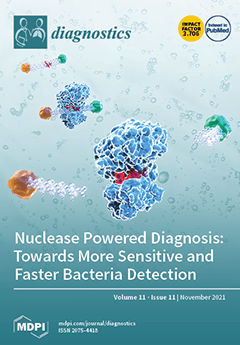Background: Heart involvement (HInv) in systemic sclerosis (SSc) may relate to myocarditis and is associated with poor prognosis. Serum anti-heart (AHA) and anti-intercalated disk autoantibodies (AIDA) are organ and disease-specific markers of isolated autoimmune myocarditis. We assessed frequencies, clinical correlates, and prognostic impacts of AHA and AIDA in SSc. Methods: The study included consecutive SSc patients (
n = 116, aged 53 ± 13 years, 83.6% females, median disease duration 7 years) with clinically suspected heart involvement (symptoms, abnormal ECG, abnormal troponin I or natriuretic peptides, and abnormal echocardiography). All SSc patients underwent CMR. Serum AHA and AIDA were measured by indirect immunofluorescence in SSc and in control groups of non-inflammatory cardiac disease (NICD) (
n = 160), ischemic heart failure (IHF) (
n = 141), and normal blood donors (NBD) (
n = 270). AHA and AIDA status in SSc was correlated with baseline clinical, diagnostic features, and outcome. Results: The frequency of AHA was higher in SSc (57/116, 49%,
p < 0.00001) than in NICD (2/160, 1%), IHF (2/141, 1%), or NBD (7/270, 2.5%). The frequency of AIDA was higher (65/116, 56%,
p < 0.00001) in SSc than in NICD (6/160, 3.75%), IHF (3/141, 2%), or NBD (1/270, 0.37%). AHAs were associated with interstitial lung disease (
p = 0.04), history of chest pain (
p = 0.026), abnormal troponin (
p = 0.006), AIDA (
p = 0.000), and current immunosuppression (
p = 0.01). AHAs were associated with death (
p = 0.02) and overall cardiac events during follow-up (
p = 0.017). Conclusions: The high frequencies of AHA and AIDA suggest a high burden of underdiagnosed autoimmune HInv in SSc. In keeping with the negative prognostic impact of HInv in SSc, AHAs were associated with dismal prognosis.
Full article






